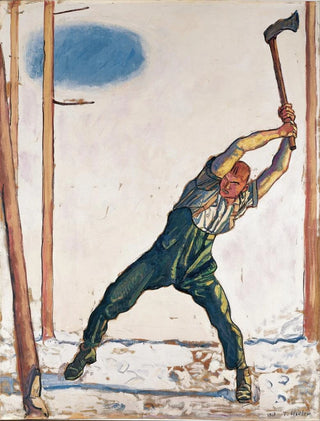Art print | Lumberjack - Ferdinand Hodler


View from behind

Frame (optional)
In the vast panorama of art history, certain works stand out for their ability to capture the very essence of humanity and nature. "Lumberjack - Ferdinand Hodler" is a perfect example. This painting, imbued with strength and poetry, immerses us in the universe of forest workers, highlighting the intimate relationship between man and his environment. The scene, vibrant with life, evokes a deep contemplation of labor, sacrifice, and the wild beauty of natural landscapes. Through this piece, Hodler invites us to reflect on our place in the world, while celebrating the dignity of work.
Style and uniqueness of the work
Ferdinand Hodler's style is characterized by a pursuit of simplicity and the power of forms. In "Lumberjack," he adopts an almost monumental approach, where clean lines and rich colors intertwine to create a harmonious composition. The figure of the lumberjack, strong and stoic, stands amidst a lush forest setting, symbolizing both man and nature. The play of light and shadow, characteristic of Hodler's work, emphasizes the relief of the muscular body of the protagonist, while the background, though detailed, remains secondary, allowing the viewer to focus on the main subject. This work is a perfect illustration of symbolist art, where each visual element carries meaning and emotion, transcending mere realism to touch on the universal.
The artist and his influence
Ferdinand Hodler, an emblematic figure of Swiss art, managed to mark his era with a unique and bold vision. Influenced by symbolism and post-impressionism, he developed a personal style that allows him to explore profound themes such as life, death, and nature. His work goes beyond simple representation; it is part of a spiritual and existential quest. Through "Lumberjack," Hodler does not merely depict a man at work but evokes a reflection on human effort in the face of nature's forces. His influence extends well beyond Swiss borders, inspiring many artists around the world, who see in

Matte finish

View from behind

Frame (optional)
In the vast panorama of art history, certain works stand out for their ability to capture the very essence of humanity and nature. "Lumberjack - Ferdinand Hodler" is a perfect example. This painting, imbued with strength and poetry, immerses us in the universe of forest workers, highlighting the intimate relationship between man and his environment. The scene, vibrant with life, evokes a deep contemplation of labor, sacrifice, and the wild beauty of natural landscapes. Through this piece, Hodler invites us to reflect on our place in the world, while celebrating the dignity of work.
Style and uniqueness of the work
Ferdinand Hodler's style is characterized by a pursuit of simplicity and the power of forms. In "Lumberjack," he adopts an almost monumental approach, where clean lines and rich colors intertwine to create a harmonious composition. The figure of the lumberjack, strong and stoic, stands amidst a lush forest setting, symbolizing both man and nature. The play of light and shadow, characteristic of Hodler's work, emphasizes the relief of the muscular body of the protagonist, while the background, though detailed, remains secondary, allowing the viewer to focus on the main subject. This work is a perfect illustration of symbolist art, where each visual element carries meaning and emotion, transcending mere realism to touch on the universal.
The artist and his influence
Ferdinand Hodler, an emblematic figure of Swiss art, managed to mark his era with a unique and bold vision. Influenced by symbolism and post-impressionism, he developed a personal style that allows him to explore profound themes such as life, death, and nature. His work goes beyond simple representation; it is part of a spiritual and existential quest. Through "Lumberjack," Hodler does not merely depict a man at work but evokes a reflection on human effort in the face of nature's forces. His influence extends well beyond Swiss borders, inspiring many artists around the world, who see in






